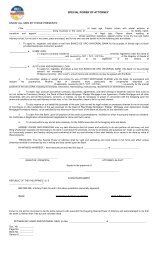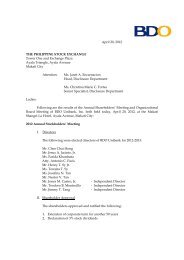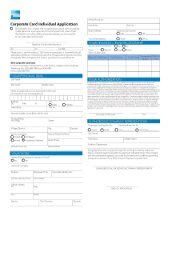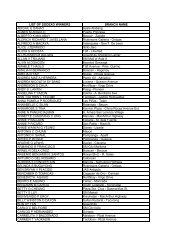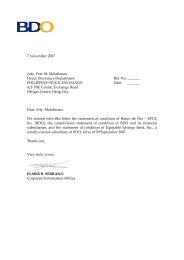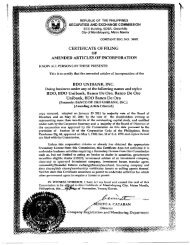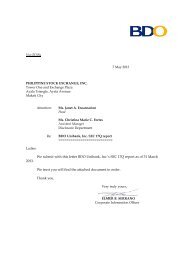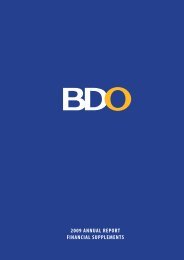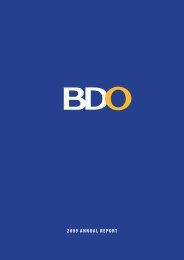Notes to Financial Statements - BDO
Notes to Financial Statements - BDO
Notes to Financial Statements - BDO
You also want an ePaper? Increase the reach of your titles
YUMPU automatically turns print PDFs into web optimized ePapers that Google loves.
<strong>Notes</strong> <strong>to</strong> <strong>Financial</strong> <strong>Statements</strong>DECEMBER 31, 2008, 2007 AND 2006(Amounts in Millions Except Per Share Data)2.19 LeasesThe Group accounts for its leases as follows:(a)Group as LessorLeases wherein the Group substantially transfers <strong>to</strong> the lessee all risks and benefits incidental <strong>to</strong> ownership of the leased item areclassified as finance leases and are presented as receivable at an amount equal <strong>to</strong> the Group’s net investment in the lease. Financeincome is recognized based on the pattern reflecting a constant periodic rate of return on the Group’s net investment outstanding inrespect of the finance lease.Leases, which do not transfer <strong>to</strong> the lessee substantially all the risks and benefits of ownership of the asset are classified as operatingleases. Operating lease collections are recognized as income in the income statement on a straight-line basis over the lease term.(b)Group as LesseeLeases, which do not transfer <strong>to</strong> the Group substantially all the risks and benefits of ownership of the asset are classified as operatingleases. Operating lease payments are recognized as expense in the income statement on a straight-line basis over the lease term.The Group determines whether an arrangement is, or contains a lease based on the substance of the arrangement. It makes an assessmen<strong>to</strong>f whether the fulfillment of the arrangement is dependent on the use of a specific asset or assets and the arrangement conveys a right <strong>to</strong>use the asset.2.20 Impairment of <strong>Financial</strong> AssetsThe Group assesses at each statement of condition date whether there is objective evidence that a financial asset or group of financial assetsis impaired. A financial asset or a group of financial assets is impaired and impairment losses are incurred if, and only if, there is objectiveevidence of impairment as a result of one or more events that occurred after the initial recognition of the asset (a loss event) and that loss eventhas an impact on the estimated future cash flows of the financial asset or group of financial assets that can be reliably estimated. Objectiveevidence that a financial asset or group of assets is impaired includes observable data that comes <strong>to</strong> the attention of the Group about certainloss events, including, among others: (i) significant financial difficulty of the issuer or deb<strong>to</strong>r; (ii) a breach of contract, such as a default ordelinquency in interest or principal payments; (iii) the probability that the borrower will enter bankruptcy or other financial reorganization; (iv)the disappearance of an active market for that financial asset because of financial difficulties; or, (v) observable data indicating that there is ameasurable decrease in the estimated future cash flows from a group of financial assets since the initial recognition of those assets, althoughthe decrease cannot yet be identified with the individual financial assets in the group.(a) Assets carried at amortized cost. The Group first assesses whether objective evidence of impairment exists individually for financial assetsthat are individually significant and individually or collectively for financial assets that are not individually significant. If the Group determinesthat no objective evidence of impairment exists for an individually assessed financial asset, whether significant or not, the Group includesthe asset in a group of financial assets with similar credit risk characteristics and collectively assesses them for impairment. Assets thatare individually assessed for impairment and for which an impairment loss is or continues <strong>to</strong> be recognized are not included in a collectiveassessment of impairment.If there is objective evidence that an impairment loss on loans and receivable or HTM investments carried at amortized cost has beenincurred, the amount of the loss is measured as the difference between the asset’s carrying amount and the present value of estimatedfuture cash flows (excluding future credit losses that have not been incurred) discounted at the financial asset’s original effective interestrate. The carrying amount of the asset is reduced through the use of an allowance account and the amount of the loss is recognized inthe income statement. If a loan or HTM investment has a variable interest rate, the discount rate for measuring any impairment loss is thecurrent effective interest rate determined under the contract. When practicable, the Group may measure impairment on the basis of aninstrument’s fair value using an observable market price.The calculation of the present value of the estimated future cash flows of a collateralized financial asset reflects the cash flows that mayresult from foreclosure less costs for obtaining and selling the collateral, whether or not foreclosure is probable.For the purpose of a collective evaluation of impairment, financial assets are grouped on the basis of similar credit risk characteristics,i.e., on the basis of the Group’s or BSP’s grading process that considers asset type, industry, collateral type, past-due status and otherrelevant fac<strong>to</strong>rs. Those characteristics are relevant <strong>to</strong> the estimation of future cash flows for groups of such assets by being indicative ofthe deb<strong>to</strong>rs’ ability <strong>to</strong> pay all amounts due according <strong>to</strong> the contractual terms of the assets being evaluated.Future cash flows in a group of financial assets that are collectively evaluated for impairment are estimated on the basis of the contractualcash flows of the assets and his<strong>to</strong>rical loss experience for assets with credit risk characteristics similar <strong>to</strong> those in the group. His<strong>to</strong>rical lossexperience is adjusted on the basis of current observable data <strong>to</strong> reflect the effects of current conditions that did not affect the period onwhich the his<strong>to</strong>rical loss experience is based and <strong>to</strong> remove the effects of conditions in the his<strong>to</strong>rical period that do not exist currently.Estimates of changes in future cash flows for groups of assets should reflect and be consistent with changes in related observable datafrom period <strong>to</strong> period. The methodologies and assumptions used for estimating future cash flows are reviewed regularly by the Group <strong>to</strong>reduce any differences between loss estimates and actual loss experience.Thinking Ahead To Get You Ahead • Annual Report 2008 19



